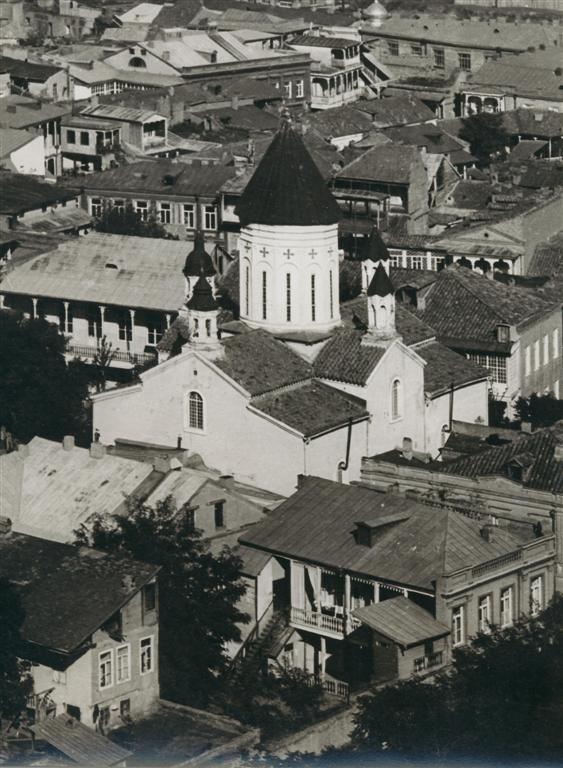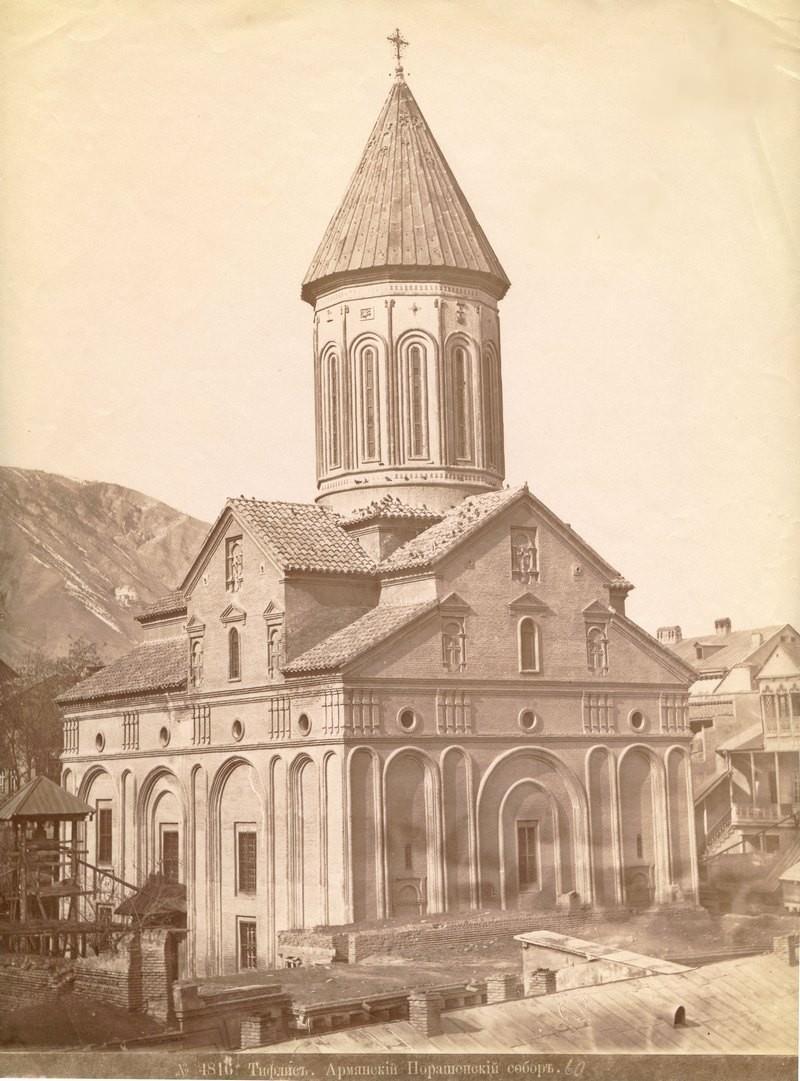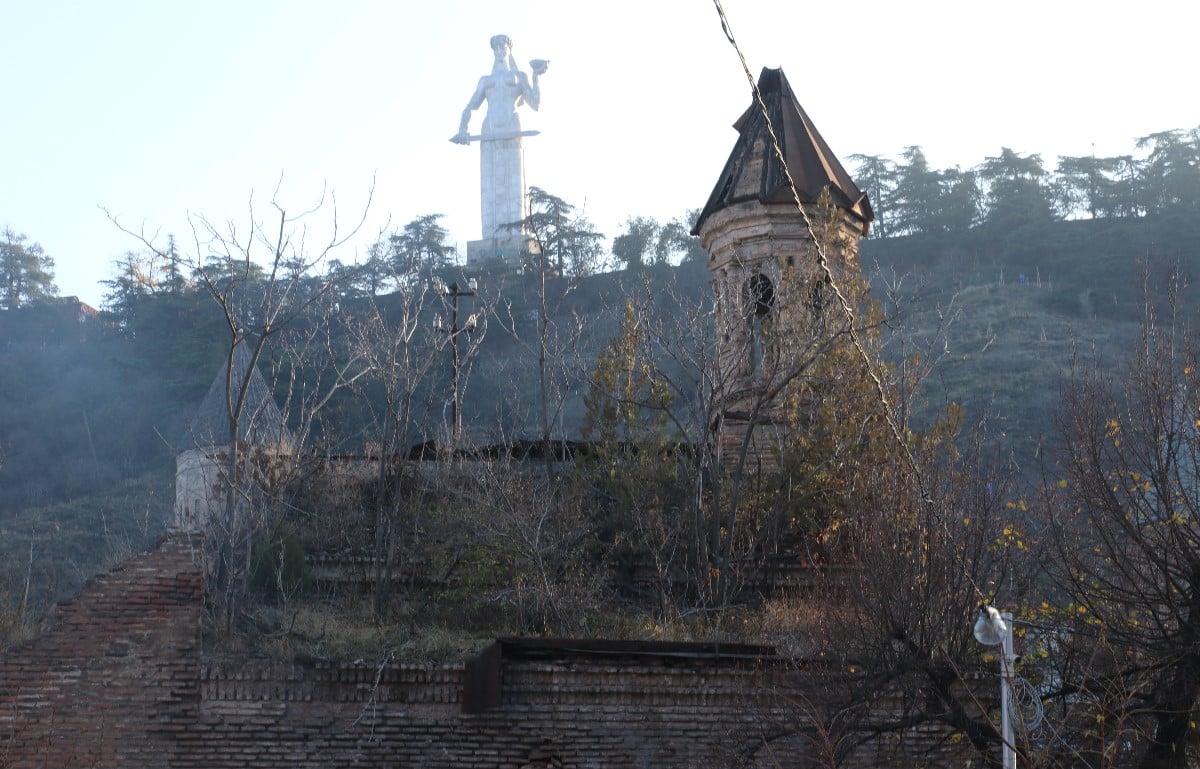“There are 69 Armenian churches in Georgia, two of which are in the capital Tbilisi,” wrote Bishop Davtyan, the leader of the Armenian Diocese of Georgia, responding to a written inquiry from “Verified.” While wandering through the streets of Georgia’s capital, one will likely stumble upon many abandoned, dilapidated churches. These churches have been at the center of a long-standing dispute between the Georgian Orthodox and Armenian Apostolic Churches. Unfortunately, the spiritual authorities of both countries have failed to reach an agreement regarding the ownership of these churches.
Setting aside the debates surrounding the origin and ownership of the churches, we will examine the current state of these religious buildings and their condition resulting from disagreements between the two countries.
According to the Armenian Diocese of Georgia, six churches are subject of controversy: Saint Minas of Yerevantsots in Tbilisi, Saint Gevorg of Mughnu (Mughnu Mets), Red Gospel of Shamkhoretsots, Saint Nicholas (Saint Nicholas), Norashen Saint Astvatsatsin, and Saint Nshan of Akhaltskha (St. Vardanants).
St. Minas
Yerevantsots St. Minas Armenian church is located not far from St. Etchmiadzin church in Avlabari district. The church was established in 1790, as confirmed by Armenian and Georgian sources. At one point, the church encompassed the entire length of the street. However, presently, the wooden roof has completely collapsed, and the east and west facades lack pediments.
According to Armenianchurch.ge, in 1924, due to the anti-religious policies of the Bolsheviks, St. Minas Church was handed over to the Avlabari district committee by the Central Executive Committee of Tbilisi. The purpose of this was to convert the church into a district club. During the Soviet era, the church dome was eliminated and used as a workshop. After the collapse of the USSR, Yerevantsots St. Minas Church was determined to be one of the “disputed” churches.
In 2007, St. Minas was granted the status of a historical monument, but this did not contribute to the preservation of the church. In 2014, due to heavy rains, the roof of the church collapsed; however, instead of repairing it, the municipality chose to remove the roof entirely. Following the fire in 2019, the church is now on the verge of complete destruction.
IDPs currently reside in the churchyard. In a conversation with the Georgian Human Rights Organization, they asserted that the government allocated the territory to them. One of them privatized the church’s basement and arranged a cellar in it. Residents mentioned they are willing to vacate the church area if the state provides an alternative.
In 2013, the Armenian Diocese of Georgia petitioned the General Prosecutor’s Office to investigate the legality of the cathedral’s privatization and the surrounding area. However, the case was ultimately dismissed.
Subsequently, On 7 October 2014, a representative of the Georgian Diocese of the Armenian Holy Apostolic Orthodox Church addressed the Public Defender with a request to study the legality of alienation of the so-called disputed temple named after St. Minas and its adjacent territory.
In 2016, Father Mikael Botkoveli, the secretary of the Patriarchate of Georgia, stated to Human Rights advocates that the Armenian Diocese holds unrealistic claims regarding the churches.
“The historical issues between us stem from the period when Armenians used to purchase temples in Tbilisi. How can over 600 churches in Georgia be Armenian? They assert ownership of numerous churches, making dialogue with them challenging due to their unrealistic claims,” expressed the speaker.
“Verified’s” visit to the church grounds revealed that the situation remains unchanged. Presently, the church is in a deteriorated state; the area is littered with garbage, and private structures occupy the territory. One of the residents informed us that he was displaced from Abkhazia and had no alternative accommodation.
In response to an inquiry from “Verified,” the leader of the Armenian Diocese of Georgia stated that the Diocese is unable to evict the residing IDPs from the church territory. The Georgian government accommodated these people. The Diocese is unsatisfied with this situation and has raised the issue of turning the churchyard into a residential area. However, they cannot remove the families living there from the church premises and resettle them elsewhere. The Diocese lacks the power and opportunity to do so.
Saint Gevork of Mughni
The Saint Gevork of Mughni Church is in the Sololaki district of Tbilisi, a popular tourist destination. There are differing opinions about when the church was founded. According to official Georgian sources, the church was established in 1751. However, the Armenian side mentions the dates 1356 or 1537.
According to the Armenian Diocese of Georgia, during the Soviet period, St. Gevorg was turned into a warehouse. Over the years, the building fell into neglect and decay. In the 1990s, the structure state was recognized as unsafe and finally closed.

Saint Gevork of Mughni at the beginning of the 19th century. photo: Dmitry Yermakov
The church received the status of cultural heritage in 2007; despite this, it is in a deplorable state. In 2009, the dome and most of the walls of the church collapsed, leaving the structure in ruins. Despite being under the jurisdiction of the Ministry of Culture and Monuments Protection of Georgia, no steps have been taken to restore the church. To prevent people from entering, a net was placed between the entrance doors; however, even this measure is not being followed. Stray cats have taken up residence inside the church, and locals and tourists often disregard the nets to feed them.
Shamkoretsots St. Astvatsatsin
Shamkoretsots St. Astvatsatsin, also known as the Red Gospel, is situated at 21 Peristsvaleba Street in Avlabari. The church is commonly referred to as the Red Gospel because of the red gospel kept in the Tabernacle and its construction from red tufa.
There is some discrepancy regarding the establishment date of the church. The Armenian Diocese of Georgia states that it was built in 1735, while the National Agency for the Preservation of Cultural Heritage of Georgia suggests that it was constructed in the 1840s. According to the latter, the church was established by Armenians exiled from Shamkori (Azerbaijan). After the Soviet regime came to power, Shamkoretsots, like other Armenian churches in Tbilisi, was also closed down. During this time, the church was repurposed for various uses, including being turned into a bakery and warehouse. In the 1980s, it was converted into a studio for Georgian artists. Unfortunately, the church was mostly destroyed in April 1989, purportedly due to an earthquake (though the Armenian Diocese of Georgia believes it was done intentionally).
Shamkoretsots was the largest church in Tbilisi during the Soviet era and was 40 meters tall. However, now there is a significant risk of the church’s destruction due to fires that occurred in 2002 and 2012. As a result, one of the walls has collapsed. Despite appeals, the government has refused to undertake restoration efforts. In 2013, the National Agency for the Preservation of Cultural Heritage of Georgia launched a competition, which “Art Building” LLC won. The company was supposed to conduct maintenance work on the church to prevent further deterioration, but the project was never implemented due to financial difficulties.
Since 2009, the Armenian Diocese of Georgia has appealed to the authorities to return the church, but these attempts have failed. As of now, only the eastern wall of the church remains standing.
In 2016, construction started on a three-story house near the Red Gospel Church, using heavy equipment that caused displacement and threatened the stability of the temple.

The “Tolerance and Diversity Institute” (TDI), an organization that focuses on the rights of national and religious minorities in Georgia, believes that the construction permit was issued in violation of the law.
The church has been granted the status of an immovable cultural heritage monument since 2007. The organization’s report states, “Construction has commenced adjacent to the wall of the temple (approximately 4-5 meters), which blatantly disregards established norms regarding cultural heritage. ”
According to information provided to TDI by Tbilisi Municipality, the Agency for the Protection of Cultural Heritage did not provide concrete evidence of damage to the monument. Therefore, no decision was made to halt the construction.
Construction started in December 2016 near the church, which involved excavating the foundation for a large apartment building. This has created an emergency situation for the church’s protection. Despite receiving numerous alarming letters from the Diocese, the issue remains unresolved. Another issue to consider is that a kindergarten once operated in the area close to the church, but it did so illegally. Stakeholders stated at the time that there was a clear boundary between the church premises and the surrounding area. However, despite these assertions, the construction works proceeded. This constitutes a violation of the law,” remarked the leader of the Armenian Diocese of Georgia in response to our inquiry.
It is noteworthy that Shamkhoretsots is under Georgian jurisdiction, and the Armenian Diocese of Georgia lacks legal power to demand the protection of the church. Georgian law permits an appeal against the act only if there is a legitimate interest in preventing damage caused by the building permit.
St. Nshan
St. Nshan is one of the oldest churches in Tbilisi. According to Georgian sources, it was built between 1703 and 1720. The Armenian Diocese of Georgia state the church dates back to 1624, oversees this church, which is situated at 6 Sultanishan Street in the center of Tbilisi.
There was a cemetery located next to the church. However, in the 1970s, most of the tombstones in the northern section were paved over. Today, only a few tombstones that were slightly higher than the others are still visible.
In 1928, St. Nshan and several other churches were shut down in Tbilisi. During World War II, the church was used as a pasta warehouse. In the early 1980s, it was turned into a book depository. Unfortunately, St. Nshan also suffered significant damage from fires. Additionally, the church housed dogs at some point.
Over the years, residential buildings have been constructed one after another next to the church. In 2011, the National Agency for the Preservation of Cultural Heritage of Georgia launched a competition won by the International Council of Monuments and Landmarks, ICOMOS Georgia. They developed a project for the complete restoration of St. Nshan and announced a new reconstruction application. In 2012, “Constructor” LLC won the tender. The company carried out fortifying works on the part of the building, which prevented the collapse of the northern part of the interior. However, the works were stopped soon after because the Tbilisi Municipality could not evict the residents residing adjacent to the church.
St. Norashen
According to the Armenian Diocese of Georgia, Saint Norashen was built in 1467 or 1507, while the Georgian side mentions 1796. The church is located at Kote Apkhazi 41, in the center of Tbilisi.
According to Human Rights, the Soviet authorities attempted to demolish the church in 1925, but were met with resistance by the people of Tbilisi. Eventually, the building was given to the Georgian Academy of Sciences to be used as a library.
In 2014, the National Agency for Cultural Heritage Preservation announced a tender won by Engineer Opinion LLC. The company was responsible for preparing the complete design documents required for the restoration of St. Norashen church. The restoration works in the church were commenced by “Aba Group” LLC in September 2014. The Georgian Historical Monuments Conservancy was responsible for executing the restoration works.

St. Norashen at the beginning of the 20th century, photo from Wikipedia
Despite being non-functioning, Srb Norashen is preserved according to the Armenian Diocese of Georgia, along with St. Nshan.
“The Armenian Diocese of Georgia has expressed gratitude towards the authorities for their efforts in preserving the churches. The territories of these churches have been fenced, and fortifying works have been carried out to prevent further collapses. The Diocese is working towards expanding the list of preserved churches to include other bowed but standing churches, which will protect them from destruction. Additionally, the Diocese is continuing its work towards returning the disputed Armenian churches to their rightful place within the Diocese.”
Thus, there are at least five disputed churches in Tbilisi that the Armenian and Georgian churches cannot “share.” Due to the differences between the two churches, cultural monuments, which, regardless of their affiliation, were integral parts of the history of the two nations, are affected. These churches are now neglected; some are on the verge of destruction.
* The photos published on the Flourish platform for this article are the property of media.am. They can be used by referencing media.am.







